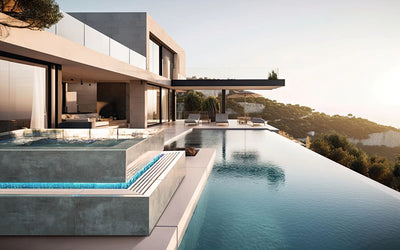Ever dreamed of stepping from your kitchen into a garden office without braving the cold?
Yes, garden rooms can be attached to your house, but once they are, they stop being “garden rooms” and become full-on house extensions.
There’s a lot to love, but also a lot to consider. From planning permission to cost and structure, there’s more beneath the surface than you might expect.
Stick around if you want a smoother project and fewer nasty surprises.

The Simple Answer: Yes, But It's No Longer a "Garden Room"
Understanding the Shift: From Outbuilding to Extension
Let’s be clear, once a garden room is attached to your home, it’s no longer classed as a garden room. It becomes a traditional house extension.
That simple attachment changes everything. Garden rooms are usually seen as outbuildings, which means fewer rules. But attach it? You’re playing by a different rulebook.
Think of it like this: a freestanding garden room is a guest sleeping in the backyard. An attached one? They’ve just moved in permanently.
Why a Detached Structure is the Standard for Garden Rooms
Detached garden rooms are popular because they’re straightforward. Less red tape, less disruption, and far fewer costs.
You don’t have to mess with your home’s structure or apply for complex permissions. You just find your spot, follow the guidelines, and build. That’s the beauty of the “detached” route, it gives you freedom.
The Critical Impact on Planning Permission
Why Permitted Development Rights No Longer Apply
Permitted development rights make life easy, but only for detached garden rooms.
Once the structure touches your house, those rights no longer apply. You step out of the relaxed garden room zone and into formal planning territory.
This is where many homeowners get caught off guard. Don’t assume you can attach a room and skip the paperwork.
It Will Be Treated as a House Extension by Your Local Authority
Your local council won’t care if you call it a garden room. If it’s attached, they treat it as a full-blown extension.
That means stricter height limits, floor area caps, and even rules about where windows go. You might need neighbour sign-offs or to meet conservation standards if your area has special restrictions.
When You Will Need to Submit a Full Planning Application
If you’re building near a boundary, going tall, or adding a room in a conservation area, you’ll likely need full planning permission.
Listed properties or homes that have already been extended? Definitely. And if you’ve already used your permitted development rights? No shortcuts here.
Bottom line: always check with your council before laying a single brick.

Building Regulations: The Non-Negotiable Requirements
Why Attaching a Structure Immediately Involves Building Regulations
The second you connect anything to your home, building regulations come into play.
This isn’t optional. These rules are there to protect you, from structural disasters, fire risks, and freezing winters. Ignoring them isn’t just risky, it can also make it harder to sell your home later.
Key Areas of Compliance
Structural Integrity and Foundations
First things first, can your current wall even support the new room?
Load-bearing checks and solid foundations are a must. Expect reinforced bases, soil tests, and structural sign-offs from engineers.
Fire Safety and Escape Routes
Fire safety isn't just a box-ticking exercise. If you’re attaching a room, you need clear exit paths, fire-rated materials, and maybe even internal fire doors.
No shortcuts, this is about keeping people safe.
Thermal Efficiency and Insulation
If you want a cosy space all year round, you’ll need to meet current energy standards.
That means high-quality insulation, energy-efficient glazing, and smart design to reduce heat loss. Otherwise, your garden room will either feel like an oven or an icebox.
Ventilation
Poor airflow = condensation, mould, and misery.
Regulations demand proper ventilation to keep your space fresh and healthy. Think trickle vents, extractors, or even mechanical systems depending on your setup.
Cost and Complexity: Attached vs. Detached
Why an Attached Build is Significantly More Expensive
Attaching a garden room sounds simple, until you start the work.
You’re not just adding a box; you’re integrating a whole new structure into your existing home. That means extra insulation, structural upgrades, and waterproofing.
Detached builds? Much cheaper and far less invasive.
The Need for Architects, Structural Engineers, and Detailed Plans
This isn’t a weekend DIY job. You’ll need architects, possibly structural engineers, and a contractor who knows how to navigate the legal maze.
And yes, all of this adds time and cost to your project.
The Disruption of Breaking into Your Home's Structure
Brace yourself for noise, dust, and some chaos.
Attaching a structure means knocking through walls, possibly lifting floors, and even temporarily cutting off parts of your home.
Detached garden rooms? No such drama.
Is Attaching a Garden Room the Right Choice for You?
The Benefits: A Seamless Connection to Your Home
There’s no denying the perks of an attached garden room.
It feels like a natural extension of your house. You can flow straight from the kitchen into your new office, yoga room, or creative studio without stepping outside.
And with the right design, it can boost your home’s value significantly.
The Alternatives: A Covered Walkway or Adjoining Deck
Want to keep things simple but still feel connected?
Try adding a covered walkway or a stylish decking bridge. These keep your garden room legally “detached” but functionally close enough to feel part of the house.
It’s a clever compromise with a lot less red tape.
Why a Detached Garden Room is Often the Simpler, Cheaper, and Faster Option
If your priority is speed, cost, and less hassle? Go detached.
You’ll likely avoid planning permission, reduce building regulation issues, and skip the structural drama.
Detached garden rooms offer flexibility without the complexity of becoming an extension.

Our Verdict: Think 'Extension', Not 'Garden Room'
So, can you attach a garden room to your house? Yes. But be ready for it to be treated as a full house extension.
That means more money, more time, and more planning.
If you love the idea of a seamless space and have the budget, go for it, with professionals on your side. But if you want a quicker, more affordable way to add space? A detached garden room might just be the smarter move.
Choose wisely, and plan before you build.









